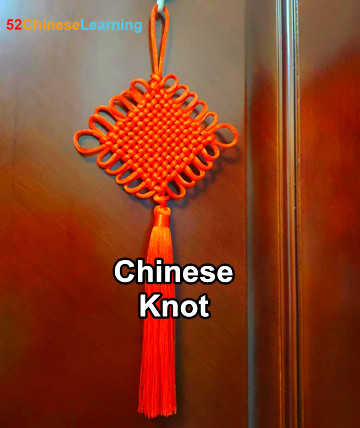链接复制成功!现在分享给好友吧。
Knots are one of the first technologies created by ancient civilizations, especially the Chinese knot. Consequently, they have an imperative role in material culture.
For many ancient cultures, knots are symbols. Knots are connections between man and the universe. A translation for the flow of time. Every entanglement and interlocking is the embodiment of the cosmos’ passage of time. That is why the knots tangle, twist, fray, and rejoin. Knots are the arts of deities.
That is also the case in China. Knots symbolize longevity and eternity. These braided cords are incredibly imperative in China that they became a culture. That’s what we are exploring today. The history and meaning of the Chinese knot 中国结 (Zhōngguó jié).

The Chinese knot 中国结 (Zhōngguó jié) is an ancient art that persists to this day. The art is sophisticated. Each one is hand-woven meticulously and delicately. Usually, 中国结 (Zhōngguó jié) comes in an intricate symmetrical pattern. However, it may also have different knot forms. Each pattern represents different values, ideas, and connotations.
Chinese knots date back to the Han civilization. It represents the affection and wisdom of the Han civilization. Moreover, it shows their rich history, nationality, customs, and aesthetic sense.
To know more about Chinese knots, let us explore their different aspects.
All culture starts from the Paleolithic Era; the Chinese Knot is no different. It merely started as a culture of convenience. After all, knots are inherently sturdier than typical ties. As time progresses, Chinese knots become a ceremonial culture. They served as totems and imperative ceremonial relics in this era. However, as the world moved towards modernization, these cultures gradually died down. Consequently, Chinese Knots became decorative art.
中国结 (Zhōngguó Jié) is progressive folk art. It played specific roles in different Chinese eras. In the Zhou dynasty, people often wear jade decorations with The Chinese knot 中国结 (Zhōngguó jié). In the Warring States Period bronzes contain the intricate design of the Chinese knot 中国结 (Zhōngguó jié). The practice continued to the Qing Dynasty. Chinese knot 中国结 (Zhōngguó jié) has become popular folk art.
Today, it lost its religious and ritualistic aspects. Now, it is merely a beautiful decoration. People use this to embellish indoors and sometimes use it as a gift for relatives and friends.
Chinese knots are born from a single silk thread gracefully formed into knot patterns. Each entanglement has a specific meaning and connotation.
Chinese knots are essentially different loops combined together. These combinations create intricate, complex patterns that are simply gorgeous and sophisticated. Some people use double money knot and button knot. Others prefer pipa knot, group brocade knot, and cross knot. There are a plethora of ways to make 中国结 (Zhōngguó jié). Among these ways are auspicious knot, swastika knot, plate-long knot, caisson knot, double connection, bowknot, brocade knot, and more.
People often use Chinese knots as decorative items. Sometimes they also use it as a braid. It comes in different materials. The most common ones used are silk, cotton, hemp, and nylon
Chinese knots are China’s unique folk art. It is the product of exquisite workmanship perfected in different generations. In addition, Not only is it unique, but it is also the epitome of hard work and perseverance. Furthermore, the patterns present in Chinese knots represent specific values. Among these are unity, happiness, and peace. Chinese knots contain charm and history that fully reflects the wisdom of the Chinese people. It is so imperative in the Chinese culture that it is present during Beijing’s bid for the Olympic Games.
The Chinese knot 中国结 (Zhōngguó jié), as a symbol of Chinese traditional culture, was deeply loved by friends from all over the world.
中国结(Zhōngguó jié): a kind of hand-woven handicraft that shows the affection and wisdom of the Ancient Han civilization
中(Zhōng): the first tone, central, center, middle, in the midst of, hit (target), attain
国(guó): the second tone, nation, country, nation-state
结(jié): the second tone, knot, tie, join, connect
Examples
Zhōngguó jié tǐ xiàn le Zhōng guó de chuán tǒng wén huà.
中 国 结体 现了 中 国 的 传 统 文 化。
The Chinese knot embodies the traditional culture of China.
Zhōngguó jié kě yǐ zuò wéi lǐ wù sòng gěi qīn péng hǎo yǒu.
中 国 结 可 以作 为礼 物 送 给 亲 朋 好 友。
Chinese knots can be given as gifts to relatives and friends.
Your first 1-on-1 Chinese lesson offer